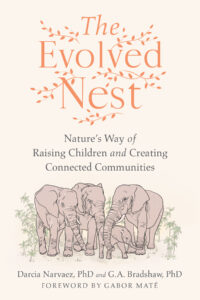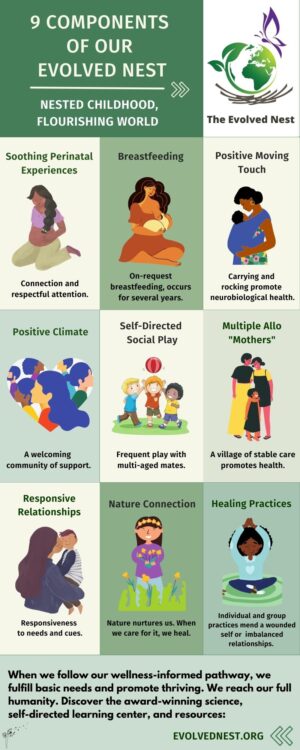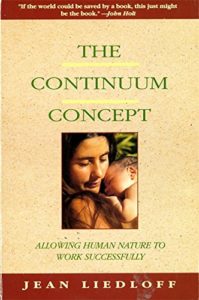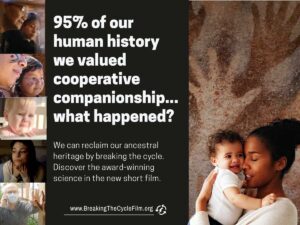Editor’s Note: Below you will find Chapter One, entitled Nature’s Way, of the new book, The Evolved Nest: Nature’s Way of Raising Children and Creating Connected Communities by Darcia Narvaez and G.A. Bradshaw.
Watch the short film that accompanies the book here and below.
Listen to the Kindred podcast with the author’s here.
Watch a mother ask the authors How To Create Nestedness in an Untested World, a Kindred exclusive video interview.
Read the foreword to the book by Gabor Maté, MD, here.
Read endorsements for the book here.
Visit the Evolved Nest Learning Center to learn more about our evolved nest here.
The Evolved Nest: Nature’s Way of Raising Children and Creating Connected Communities
CHAPTER ONE: NATURE’S WAY
Webbed feet planted on the Antarctic ice, a father bends down to tend his son. High in the canopies of the Amazon, nestlings raise their beaks to join the family chorus. Under the heat of the African sun, trunks of mother and aunts reach out to help the newborn stand. Below the sparkle of Atlantic waves, a baby Whale glides alongside his mother. Large or small, land-born or water-born, they are immersed in love. Their hearts beat with the same song that has been passed down generation after generation, lessons from the mother of them all, Nature. These melodies are faint in our human lives today. Heavy from forgetfulness, hearts and minds have grown weary and brittle. How do we recover this reverential song of wellness? When we relearn, rejoice, and rejoin Nature’s way.
***
 In the dazzle of Nature’s extraordinary diversity, it’s easy to overlook how similar we are. Even though humans and other Animals look different on the outside, inside—beneath the fur, fins, feathers, scales, and skin—we are very much alike, including our brains. Animals ranging from the giant Sperm Whale and the tuxedoed Penguins to the ancient African Elephant and the astonishing Octopus share with humans brain structures and processes that give us capacities for consciousness, thinking, feeling, loving, and dreaming. We also share a common system for raising our young: the evolved nest.
In the dazzle of Nature’s extraordinary diversity, it’s easy to overlook how similar we are. Even though humans and other Animals look different on the outside, inside—beneath the fur, fins, feathers, scales, and skin—we are very much alike, including our brains. Animals ranging from the giant Sperm Whale and the tuxedoed Penguins to the ancient African Elephant and the astonishing Octopus share with humans brain structures and processes that give us capacities for consciousness, thinking, feeling, loving, and dreaming. We also share a common system for raising our young: the evolved nest.
Evolved nests are developmental systems tailored to nurture psychological, social, and physical needs in a species-unique manner. “Nests” don’t always look like the cupped constructions of twigs and branches that many Birds make. The African Elephant evolved nest is a social and ecological environment centered around the natal family—mothers, aunts, cousins, sisters, and brothers—who form a nucleus of care. The same goes for Sperm Whales. Their evolved nests are shaped by the folds of ocean currents and a matrilineal family that nurtures young Whales’ minds and bodies in the ways of their watery home.

Every species’ nest has been perfected through evolution to optimize health and well-being, starting from conception through adulthood. Each is a tried-and-true system validated over millions of years. The more an Animal and their young mesh with the natural surroundings, the better chance they have to thrive. The same goes for humans. We and our children do best in conditions like those in which we evolved as a species.
Today’s culture of cars, manufactured houses, and technology in which most children are immersed, however, is a far cry from our evolutionary roots. As Jean Liedloff discovered, the gap between how our ancestors lived and how we live today has generated issues and symptoms in our youth and society that are absent in cultures that retain humanity’s natural heritage. The poor mental and physical states of industrialized humans might be widespread, but they are in no way “normal” relative to our Nature-based human ancestry.
Jean Liedloff was a fashionable socialite living in the rarefied circles of New York and Paris of the 1950s until one day, on impulse, she joined an expedition to the jungles of Venezuela in search of diamonds. It was a decision that took an unexpected twist, transforming her very core, and leading her to write the landmark book The Continuum Concept: In Search of Happiness Lost.
During multiple visits over two and a half years, Liedloff lived among the Amazonian Ye’kuana, who took in this stranger from a strange land to partake in their everyday lives. At first, Liedloff was both enthralled and appalled—enthralled by Nature’s beauty and appalled by village life. With disbelief, she observed the cumbersome and difficult ways that the community seemed to function. She couldn’t understand how women made their way down a tricky, slippery mountainside to collect water from a stream, not just once but several times a day, all the while balancing babies on their hips or backs.
In Liedloff’s opinion, there must be a better way. She thought the entire enterprise was unnecessarily dangerous, tiresome, and inefficient. This was the purpose, she reasoned, of modern progress—to improve upon the way things were done in the past. More startling was the difference between her struggles fetching water, washing clothes, and cooking cassava and how the Ye’kuana women undertook the same work. They were graceful and gracious, showing pleasure and enjoyment in their work together, however difficult. Liedloff found it all perplexing. Then she had a revelation that broke through what she later realized were culturally conditioned perceptions. It opened her eyes to an entirely new view of life.
 One morning, watching her European friends and Ye’kuana men dragging a heavy dugout canoe up the river bank, Liedloff was shocked at the contrast. “Here before me were several men engaged in a single task,” she reflected later. “Two, the Italians, were tense, frowning, losing their tempers at everything, and cursing nonstop.” On the other hand, the Ye’kuana men “were laughing at the unwieldiness of the canoe, making a game of the battle, relaxed between pushes, laughing at their own scrapes and especially amused when the canoe, as it wobbled forward, pinned one, then another, underneath it.… All were doing the same work, all were experiencing the strain and pain. There was no difference in our situations except we had been conditioned by our culture to believe that such a combination of circumstances constituted an unquestionable low on the scale of well-being and were quite unaware that we had any option in the matter.” The Ye’kuana men, she went on to recount, “were in a particular merry state of mind, reveling in the comradery.… Each forward move was for them a little victory.”
One morning, watching her European friends and Ye’kuana men dragging a heavy dugout canoe up the river bank, Liedloff was shocked at the contrast. “Here before me were several men engaged in a single task,” she reflected later. “Two, the Italians, were tense, frowning, losing their tempers at everything, and cursing nonstop.” On the other hand, the Ye’kuana men “were laughing at the unwieldiness of the canoe, making a game of the battle, relaxed between pushes, laughing at their own scrapes and especially amused when the canoe, as it wobbled forward, pinned one, then another, underneath it.… All were doing the same work, all were experiencing the strain and pain. There was no difference in our situations except we had been conditioned by our culture to believe that such a combination of circumstances constituted an unquestionable low on the scale of well-being and were quite unaware that we had any option in the matter.” The Ye’kuana men, she went on to recount, “were in a particular merry state of mind, reveling in the comradery.… Each forward move was for them a little victory.”
Liedloff had also started to notice how she had changed. Much to her surprise, she “flourished.” Her body became lither, her mind clearer, and her mood lighter. Life was happier. Relative to their North American and European counterparts, the Ye’kuana emerged as exemplars of excellent mental and physical health. They worked hard, but there was no trace of the systemic social decay that ravages modern society: illness, addictions, child abuse, domestic violence, and suicide.
Notably, the Ye’kuana lived intimately interconnected with the fabric of the natural world. Instead of trying to reshape the land to fit some abstract ideal, their lives aligned with Nature’s contours and practices. Amazonian Animals, Plants, and humans thrived, water was clean and fresh, no one was homeless, and there was a deep sense of belonging. Nature was not viewed as a counterforce to be reckoned with, but a river of change in which all life participated.

The Ye’kuana lived within Nature’s gift economy, where food and care are shared in response to another’s need rather than being withheld as a means of control. Food, time, and attention were freely shared. Haunani-Kay Trask describes how a similar ethic existed in the Hawai’ian Islands (before being supplanted by the European paradigm of exchange), where giving is performed in order to receive: “Before the coming of colonization, Native society was a familial relationship organized by tribes or chiefdoms in which the necessities of life—land, water, food, collective identity and support—were available to everyone.”
What impressed Liedloff the most was how this philosophy carried through to childcare. Confident in children’s inner guidance, the community provided support as needed, such as breastfeeding and suckling on request. Amazonian babies were loved unconditionally. Compared to what Liedloff observed in the United States and Europe, Ye’kuana babies hardly cried, and their patterns of eating and sleeping were not dictated to them. They were taken in-arms wherever everyone else went, and they were carried and cuddled in contact with their mothers, family, and other community members, with the freedom to roam and play without adult interference.
All of these observations agree with those from a long line of formalized studies of Nature-based cultures by anthropologists such as Barry Hewlett, Melvin Konner, Michael Lamb, Richard B. Lee, Margaret Mead, and Elizabeth Marshall Thomas. Liedloff came to call this human-Nature spooning an example of the ancient continuum. She maintained that to cultivate the health and well-being embodied by the Ye’kuana, and what she experienced herself, humans need to bring their lives back into alignment with Nature and the habits of our ancestors—to reorient from anthropocentrism to ecocentrism. According to Tewa educator Gregory Cajete, this understanding of human nature “embraces the inherent creativity of nature as the foundation for both knowledge and action” and maintains “dynamic balance and harmony with all relationships.”
The ancient continuum provides a roadnmap to heal and anneal our individual selves and our communities, which have been fractured and inflamed with alienation and intolerance. By relearning and molding our minds and relationships to fit the ways of the cosmos, we can craft wise practices and a moral path to live within Nature’s capacity. As Vine Deloria Jr. (Standing Rock Sioux) observes:
The wise person will realize his or her own limitations and act with some degree of humility until he or she has sufficient knowledge to act with confidence. Every bit of information must be related to the general framework of moral interpretation as it is personal to them and their community. No body of knowledge exists for its own sake outside the moral framework of understanding. We are, in the truest sense possible, creators or co-creators with the higher powers, and what we do has immediate importance for the rest of the universe.
Liedloff’s continuum concept radicalized popular Western views on culture and child-rearing. Since the 1975 publication of The Continuum Concept, scientific studies have proliferated to validate Liedloff’s personal observations on how early life experience has far-reaching impacts, not only on child health and well-being but also on that of the entire human and nonhuman world.
Researchers have looked deeper, beyond behavior, into the psychology and ethics of ancient and contemporary Nature-based cultures—those that are shaped by an embodied wisdom of mutuality and respect. Recalling the wayfinding of Nature-based peoples, anthropologist Wade Davis describes how “every animal and object resonates with the pulse of an ancient event, while still being dreamed into being. The world as it exists is perfect, though constantly in the process of being formed. The land is encoded with everything that has ever been, everything that ever will be, in every dimension of reality. To walk the land is to engage in a constant act of affirmation, an endless dance of creation.”
The point is not to portray a Rousseau-like painting of an idyllic Eden, but to underscore a vital difference between current domination-oriented human societies and those that flourished before global colonization. The reason that the Lakota Sioux, Quechua, Ye’kuana, Bears, Wolves, and Beavers have flourished for many thousands of years without destroying their habitats as modern industrialized societies have, is because they have sought to fit in with Nature. Nature-based cultures demonstrate how humans and Animals share landscapes and enhance all of Earth’s life by mirroring each other with similar diets, patterns of mobility, ethics, and childcare. This raises the questions: Given the ancient continuum’s evolutionary success, why is it largely absent in contemporary human societies? What happened?
Around ten thousand years ago, perhaps due to climate change or population pressures, human cultures in several areas shifted. Communities started to step outside their evolutionary heritage and break with Nature’s gift economy. Over the course of several millennia, these few groups of humans began to enslave Plants and Animals. Communities became increasingly more dependent on agriculture and less reliant on foraging. Instead of regarding Animals and Plants as kin, these communities viewed and used them as commodities for human ends. As concentrated settlements of these cultures developed, they required more and more land to maintain their economies. Nature-based cultures, human and nonhuman, were obliterated and entrained by an agenda of “progress.” This mandate has not stopped. Indigenous cultures of all species struggle to maintain the health and integrity of their communities and survive the onslaught of forced globalization.
A single thought, seeded thousands of years ago, has caused a primal, life-denying wound: instead of being part of Nature, humans are apart from Nature. This one idea has fostered an illusion—a human-focused, human-constructed, human-controlled false reality—in which Nature is perceived to play a subordinate, utilitarian role. Over time, this dramatic departure from evolutionary ways expanded and exploded, pushing the planet into the Capitalocene, an era defined by massive pollution, climate crises, genocides, and ecological destruction.
There has been another by-product of the move away from Nature: the ways in which humans raise children have dramatically changed. The ancient continuum—a lifestyle that cultivates a fluid and flexible way of being, one focused on dignity and relational quality, on working with Nature, not against it—was abandoned. The effects of this shift away from the evolved nest are far-reaching.
The first years of life lay down foundational trajectories of who and how a child will be in the future. The nature and quality of a child’s early life play a key role in shaping a child’s mental and physical health and how they will relate to the world. A culture’s ideas and values that are conveyed to a child inform the ethics and relationships that they will endorse as adults. In short, how a child is treated is predictive of how they will treat the world. Biologist Humberto Maturana suggests that humans originated and evolved as Homo sapiens-amans amans, a species shaped by a biology of love. We all require tender, supportive care in childhood to promote our fullest cooperative capacities. With the rise of anthropocentric civilization, however, two other forms of humans emerged from the violation of the biology of love: an aggressive form, Homo sapiens-amans aggressans, and an arrogant form, Homo sapiens-amans arrogans.
The result is today’s dominant trauma-based culture. Instead of positive, inclusive, Nature-based ways, colonizing industrialized humans adopted what psychologists now understand to be a trauma-inducing lifestyle. The normative baseline for raising children bears little to no resemblance to that of our natural, ancestral evolved nest. Rather than being integrated in all aspects of a supportive community, most children’s experiences involve routine stress, isolation, and disconnection. In place of evolved nest inclusion, nurturance, and security, the unnested child experiences alienation, deprivation, and trauma, which often starts even prior to birth.
Mothers and their babies have been disempowered. Medicalized birth undermines a mother’s connection to and confidence in her own body. Many babies are no longer allowed to “decide their birthdays” and are instead forced into the world through planned surgery, labor-inducing methods, or preterm birth that results from the intense or chronic stress many modern mothers sustain. Such disruptions are carried through a mother’s body to the child’s. Maternal and paternal stress are transmitted to the child through DNA. The medicalized childbirth that proliferated in the twentieth century is now known to impair healthy child development. Practices such as mother-baby separation, medically unnecessary but compelled substitution of formula for breast milk, prescribed eating and sleeping schedules, and institutional care (i.e., childcare centers and preschools) are, as Jean Liedloff described, antithetical to the ancient continuum. When the evolved nest was abandoned, well-being was too.
The intergenerational support system of aunts, uncles, siblings, and grandparents, which is so formative for a child, has been torn apart across cultures over generations by slavery, industrialization, war, forced migration, and other destructive policies and agendas. Today, Western children typically live in a single-generation household without multiage companionship. Instead of outdoor self-directed social play, most young children’s time is spent in carriers or strollers, with a smartphone or computer, and in educational settings that restrict play and other natural patterns of expression. Aside from relationships with family Dogs, Cats, Horses, or other companion Animals whose lives, minds, and bodies have been shaped by human goals through domestication, children are not raised in sync with Nature’s rhythms. Instead of feeling at home in Nature, they often reflect their parents’ unfounded and exaggerated fear of the wild.
In addition, children are confronted with a threatening and hostile social world. Even while experiencing elements of evolved nest nurturance, every child, no matter where they live, directly or indirectly encounters social dysfunction in peers and adults, which manifests as widespread depression, anxiety, abuse, addiction, and bullying. As physician Gabor Maté asserts, “since we live in a society that largely denies human developmental needs—doesn’t even understand them, let alone provide for them—you’re going to have a lot of people affected in adverse ways. Most of the population, in fact.” Denial of developmental needs significantly affects children’s brains and bodies, the effects of which cascade through time into adulthood. Young generations are bombarded with the legacies of their ancestors: global suffering, extinction of the wild, and threat of ecological collapse.
We don’t have to live this way. We don’t have to subject our children to trauma-inducing practices. There is an alternative. We can embark on a wellness-informed path. We can live and thrive as other humans have who did not abandon Nature-based ways and the ancestral nest. A plethora of research ranging across neuroscience, psychology, immunology, endocrinology, anthropology, sociology, diverse health professions, and the wealth of wisdom shared by Nature-based cultures concurs. Humanity and the planet can be restored “by practicing new ways of producing and caring for one another together, a praxis of redoing, rethinking, reliving our most basic relations.” As psychologist Alison Gopnik notes, a healthy childhood is “about providing a rich, stable, safe environment that allows many different kinds of flowers to bloom. It’s about producing a robust, flexible ecosystem that lets children themselves create many varied, unpredictable kinds of adult futures.”
Traditional, Nature-based communities understand that children are humans in the making. For example, any aggressive actions in the toddler years are greeted with playful response, as everyone knows that young children are not yet fully empathic or aware of their actions’ effects. It takes decades to grow into humanity and reach one’s full, unique potential. There are critical brain developments extending well into the sixth decade of life that lend themselves to wisdom, such as synthesizing information across domains and experience. Brain-body development continues to be integrated from birth through adolescence and adulthood, giving the individual a holistic sense of self-in-the-world, self-in-relationship, self-at-home-in-the-world. Like the maturation of Elephants, Oaks, and Sequoias, human brains and minds take time and care.
For those with young or grown children whose upbringing has not conformed to the architecture of the evolved nest and the ancient continuum, there is no call for self-recrimination, guilt, or judgment. Even though these children may not have experienced nestedness in its fullness, families can provide the essence and principles of the evolved nest to nurture health and happiness. As Liedloff maintained, “I believe it is possible to start as we are … and still find a way back.… Even with a culture [that] developed without taking the real needs of its people into account, with an understanding of the human continuum, there is room to improve our chances and reduce our errors in every small way that presents itself from day to day.” This is our core take-home message: we can infuse and transform child-rearing, family life, communities, and relationships by revitalizing Nature-based values and an ethic of oneness.
The need for restoring nest consciousness could not be greater. The stakes could not be higher. Decisions regarding whether to have children and how to raise them directly affect the fate of the planet and that of our Animal and Plant kin who are balancing on the edge of extinction. Putting the lessons of this ancient and new understanding into practice is our responsibility to present and future generations, and to those of the past who have striven to uphold Nature’s ethics. As Penobscot Indigenous rights and spiritual teacher Sherri Mitchell (Weh’na Ha’mu Kwasset) asserts, “we have to stop trying to make our children fit into the world that they find themselves in, and start creating a world that fits them.” Nature created such a world.
Returning to nestedness is essential for the future of humanity and the planet. Unnested cultures will continue to be disordered and prone to violence, and will display a lack of empathy for others instead of the flexible, other-centeredness into which we evolved. This is especially so when such humans establish institutions, policies, and practices that allow them to take over the existence-scape of other species (i.e., waterways, landscape, food-source access), putting everyone—humans, Animals, Plants, and all Earthlife—at risk.
Deep, positive changes to reinstate oneness are already afoot. Human hearts are awakening to the need for a global turning, back to connection, back to partnership, back to oneness. Our Animal kin who are so close to us in body and mind provide a ready guidebook for getting our species back on track to wellness in oneness. Through testimonies from Elephant, Wolf, Penguin, and other Animal lives and loves threaded with scientific insights, The Evolved Nest describes just how to do this—how to take the first steps along the path that restores humanity to well-being and peaceful coexistence with the rest of Nature. Let us begin this journey home together.
Watch The Evolved Nest: Nature’s Way of Raising Children


